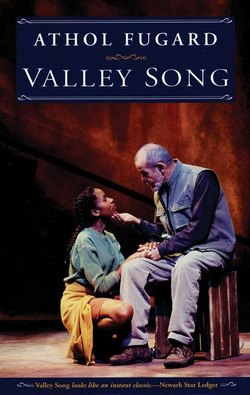Читать книгу Valley Song - Athol Fugard - Страница 8
На сайте Литреса книга снята с продажи.
NOTES
ОглавлениеKaroo: A vast semi-desert region in the heart of South Africa. “Karoo” is a Khoi word meaning “place of little water.” Several mountain ranges dot the Karoo, among them the Sneeuberg (Snow Mountains) in the southeast, whose highest peak (6300 feet) is the Kompassberg. Few plants grow on the dry mountains, but farms thrive in the valleys and lowlands. Most of the inhabitants of the Karoo are either white Afrikaners or coloreds.
The Valley: A fertile valley deep in the Sneeuberg; fruits, vegetables and alfalfa are produced there. At this time, all of the farmland is still owned by whites.
The Village: The small town of Nieu-Bethesda. Resident white population: 65; colored population: 950. Like most rural South African villages, Nieu-Bethesda is still essentially divided into two areas: the white town and the outlying “location” populated by coloreds and blacks.
Coloreds: One of four official racial categories (along with whites, blacks and Asians) of the “old” South Africa. Colored is defined as anyone of mixed racial descent. The Colored population of South Africa is approximately 4.5 million; their language is Afrikaans.
In the Karoo the earth is red and covered with small sage and milk bushes; the air is so still and clear that objects miles away seem close to you and sound travels as far as the eye can see. Day after cloudless day the sunburnt plains shimmer beneath the blue African sky; a little hillock stands out in sharp relief and, in the distance—which gives the impression of being infinite—you may see a white-painted farmhouse surrounded by orange trees. There is nothing else. This is the Karoo. And for those who have lost their hearts to it, no other place on earth can compare.
—Carolyn Slaughter
The Karoo, once you have been given the hint, is the eroded ruins of a world, the great lake and its giant reptiles gone but for a few bones and ripple marks, gone like the Sodom and Gomorrah in the earthquake and fire, epochs of reptilian life abolished, stone scorched and purged, and then sculpted clean and bare into noble shapes, the tactics of the elemental artist spelt out in the fine sand of the watercourses, his signature clear in the cirrus clouds...In that vast semi-desert it is difficult to forget your smallness.
—Guy Butler
I cannot describe my early response to the beauty of hill and stream and tree as anything less than an ecstasy...I was much older before I responded, no less intensely, to the beauty of plain and sky and distant lines of mountains. When I first saw the expanse of the...desolate stretches of the Karoo I did not at once acknowledge that they were beautiful. The qualities of harshness, starkness and seeming endlessness did not seem to me to be compatible with beauty.
—Alan Paton
The Man Born to Farming
The grower of trees, the gardener, the man born to farming, whose hands reach into the ground and sprout, to him the soil is a divine drug. He enters into death yearly, and comes back rejoicing. He has seen the light lie down in the dung heap, and rise again in the corn. His thought passes along the row ends like a mole. What a miraculous seed has he swallowed that the unending sentence of his love flows out of his mouth like a vine clinging in the sunlight, and like water descending in the dark?
—Wendell Berry
Seeds are many things, but everything about seeds—their numbers and forms and structures—has a bearing on their main purpose, to insure continuing life. Seeds are containers of embryonic plants, the embryos of a new generation. Most seeds are objects of beauty of form, proportion, surface and color. Many seeds are so small that their beautiful features escape us. Many others, although large enough to see easily, are such common, everyday objects that we do not really see them. They are, however, worth our careful observation.
—U.S. Department of Agriculture Yearbook, 1961
